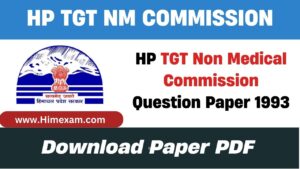Table of Contents
ToggleSolved HPSSC Opthalmic Officer(Allopathy) Post Code-804 Question Paper 2020 Set-1
||Solved HPSSC Opthalmic Officer(Allopathy) Post Code-804 Question Paper 2020 Set-1||Solved HPSSSB Hamirpur Opthalmic Officer(Allopathy) Post Code-804 Previous Year Question Paper 2020 Set-1 Answer Key Pdf||
1. Visible light splits into following number of colours when passed through a prism
(A) 5 (B) 6 (C) 7 (D) 8
2. Image formed by plane mirror is
(A) Virtual (B) Erect (C) Side to side lateralised (D) All of these
3. Image formed by a convex mirror is
(A) Virtual & Erect (B) Real & Inverted (C) Real & Magnified (D) Virtual & Magnified
4. When rays of light pass through a prism, it is
(A) refracted towards its base. (B) refracted towards its apex. (C) reflected towards its base. (D) reflected towards its apex.
5. Anterior surface of cornea behaves like
(A) Convex lens (B) Concave lens (C) Convex mirror (D) Concave mirror
6. Which of the following is not the axis of the eye ?
(A) Optical Axis (B) Linear Axis (C) Visual Axis (D) Fixation Axis
7. By direct opthalmoscope, fundus magnification is about
(A) 10 times (B) 15 times (C) 5 times (D) 3 times
8. Which of the drug is not a cycloplegic ?
(A) Atropine (B) Phenylephrine (C) Tropicamyte (D) Cyclopentolate
9. Which of the following is not a refractive error ?
(A) Myopia (B) Presbyopia (C) Hypermetropia (D) Astigmatism
10. The distance of macula from optic disk is (DD-Disk Diameter)
(A) 1 DD (B) 2 DD (C) 3 DD (D) 4 DD
11. Towards the point of reversal in retinoscopy, which is not true ?
(A) The movement of the reflex becomes faster
(B) The reflex becomes brighter
(C) The nodal point of the observer tends to coincide with the far point of the subject.
(D) The far point of the observer tends to coincide with the far point of the subject.
12. The examination of the anterior segment of eye most appropriately done by
(A) Diffused illumination
(B) Focal illumination by focusing a beam of light
(C) Using a slit lamp biomicroscope
(D) All of these
13. Distant direct ophthalmoscopy is done
(A) to examine the retina
(B) to localize the opacities in media
(C) with the help of concave mirror of focal length 25 cm
(D) All of these
14. With plane mirror retinoscopy two band shadows move in the fashion of a scissor in
(A) Hypermetropia (B) Myopia more than one diopter (C) Keratoconus (D) Astigmatism
15. For subjective verification of refraction which is not true ?
(A) Post cycloplegic test should be done (B) Cross cylinder should be used (C) Keratometric readings should be taken (D) Duochrome test is helpful
16. Normal Blind Spot is
(A) Circular (B) Vertically oval (C) Horizontally oval (D) None of these
17. Colour vision is not tested by
(A) Ishihara charts (B) Holmngren’s coloured wools (C) Duochrome test (D) Edrigreen lantren
18. In snellen’s distant test types the letters subtend at an angle of (at fixed distance)
(A) 1 minute (B) 2 minutes (C) 4 minutes (D) 5 minutes
19. Which of the following statement is wrong ?
(A) Keratomalacia is a preventable disease of infants suffering from malnutrition
(B) Keratomalacia is caused by combined deficiency of vitamin A and proteins
(C) Vitamin D and protein deficiency caused Keratomalacia
(D) Treatment of Keratomalacia consists of high doses of Vitamin A and local treatment like corneal ulcer
20. Keratoconus is best treated by
(A) Spherical lens (B) Contact lens (C) Optical iridectomy (D) Cylindrical lens
21. Photoretinitis is caused by
(A) X-rays (B) Beta rays (C) Ultra-violet rays (D) Infrared rays
22. Part of Hypermetropia which cannot be covered by accommodation
(A) Manifest hypermetropia (B) Facultative hypermetropia (C) Absolute hypermetropia (D) Latent hypermetropia
23. Distance between the centre of two pupils is
(A) Pupilary axis (B) Geometric axis (C) Optical axis (D) I.P.D.
24. Parallel rays become divergent after emerging which of the following opticals ?
(A) Convex lens (B) Concave lens (C) Prism (D) None of these
25. Which is not true for Myopia ?
(A) Can be simple or pathological
(B) Shows some hereditary transmittance
(C) Causes near poor vision thus also called short sightedness
(D) Can be corrected by concave lenses
26. The optic axis is the line passing through the centre of the lens and the center of the cornea.
(A) True (B) False (C) Partly true (D) None of these
27. Hypermetropes usually don’t have eye strain after near work.
(A) True (B) False (C) Partly true (D) None of these
28. Hypermetropia due to less curvature of cornea is called index hypermetropia.
(A) True (B) False (C) Partly true (D) None of these
29. The commonest situation of myopic cresent is
(A) Temporal (B) Nasal (C) Upper (D) Lower
30. Dextro and Levo version occur in
(A) Oblique Axis (B) Horizontal Axis (C) Anterio Posterior Axis (D) Vertical Axis
31. Angle of Deviation changes in different directions in
(A) Concomitant squint (B) Paralytic squint (C) Exotropia (D) None of these
32. On removing the cover in cover-uncover test, the eye shows abduction movement in
(A) Orthophoria (B) Esophoria (C) Esotropia (D) Exophoria
33. Exophoria is most commonly associated with
(A) Hypermetropia (B) Myopia (C) Presbyopia (D) Astigmatism
34. A squint which appears only after the removal of stimulus of fusion (as by covering an eye) is called Hetrotropia.
(A) True (B) False (C) Partly true (D) None of these
35. In a diplopia chart the farther image always belongs to the paralysed muscle.
(A) True (B) False (C) Partly true (D) None of these
36. Which of the following statement is false as regards to the concomitant squint ?
(A) Both eyes have full movement if tested separately
(B) No diplopia
(C) No false orientation
(D) Secondary deviation is greater than primary deviation
37. Hetrophoria is
(A) Tendency of the eye to deviate
(B) Manifest outward deviation of eye
(C) Manifest inward deviation of the eye
(D) None of these
38. Which one of these lenses has the spherical equivalent of +1.25 D ?
(A) 0.75 cross cylinder
(B) +4.00 = +2.00 80
(C) +2.00 = –1.50 50
(D) –4.00 = +8.00 90
39. The most rapid cycloplegia is produced by
(A) Homatropine (B) Cyclopentolate (C) Tropicamide (D) Atropine
40. The duochrome test depends on the optical principle that
(A) Light of different colours move at different speeds.
(B) Different light wavelengths are refracted to a different extent.
(C) Red and green are most easily seen by the human eye.
(D) Green light has longer wavelength than red light.
41. During accommodation all the following changes occur except
(A) Pupil contracts
(B) Anterior chambers shallows
(C) Lens becomes thinner
(D) Anterior & posterior surface of lens become convex
42. “Image Jump” occurs with
(A) Contact lenses when the eyes are moving
(B) Bifocal glasses
(C) Aphakic distance glasses
(D) Aphakic near glasses
43. An aphake will see an increase in image size of
(A) 10% (B) 15% (C) 20% (D) 30%
44. An indirect ophthalmoscope will project a/an
(A) Virtual image (B) Real image (C) Upright image (D) Flat image
45. All the following are true of cylindrical lenses except that
(A) their maximum power is at 90 to the axis.
(B) they have no power in its axis.
(C) they will have variable power.
(D) they have spherical surfaces.
46. All are true of a Hypermetropic eye except that
(A) it is deficient in refractive power.
(B) it is a negative eye.
(C) it has its far point behind the retina.
(D) presbyopia will be delayed.
47. The best way to check the optical center of eye glasses is to
(A) use a clear plastic ruler to find the geometric center of the lens
(B) use a Karatometer
(C) calculate them from the refraction
(D) use a lensometer with India ink marker
48. Which of the following are “against the rule” keratometery readings ?
(A) 44.0/44.0 at 90 (B) 45.0/45.0 at 180 (C) 44.0/46.0 at 180 (D) 43.0/48.0 at 120
49. Irregular Corneal astigmatism can best be corrected with the use of
(A) Spectacle (B) Corrected curve spectacles (C) Contact lenses (D) Aspheric glasses
50. Myopia can be associated with all the following except
(A) decreased convexity of the lens. (B) increased corneal curvature. (C) increased axial length of eye. (D) excessive plus power.
51. The reason that one cannot view the gonioscopic angle directly is
(A) the image is blurred by the cornea at the limbus. (B) the cornea is hazy near the angle. (C) spherical aberration of the cornea. (D) total internal reflection of the cornea
52. An aphake wearing aphakic glasses will most often notice
(A) Barrel distortion (B) Pin cushion distortion (C) Image jump (D) Spherical aberration
53. In progressive (malignant) Myopia, one may have all the following except
(A) Very thin sclera
(B) That the choroid becomes thickened
(C) Degeneration of the photo receptors and pigment epithelium
(D) Peripapillary Artophy
54. The followings are specific indications for cycloplegic refraction except
(A) Accommodative spasm (B) Hypermetropia (C) Strabismus (D) Contact lens fitting
55. The most common colour vision defect is
(A) Deuteranomaly (B) Rod monochromatism (C) Protanomaly (D) Tritanomaly
56. All of the following are contra-indications to the use of contact lenses except
(A) Inflammatory conditions of the cornea (B) Muscle imbalance (C) Poor motivation (D) Dusty environmental conditions
57. The image is seen behind the patient’s eye in
(A) Direct ophthalmoscopy (B) Indirect ophthalmoscopy (C) Both (A) and (B) (D) None of these
58. In Retinoscopy with a plane mirror there is no movement of the shadow in
(A) Hypermetropia (B) Myopia more than one dioptre (C) Myopia of one dioptre (D) Emmetropia
59. Gonioscopy is method for the measurement of depth of anterior chamber.
(A) True (B) False (C) Partly true (D) None of these
60. To correct astigmatism, the axis of a cylinder should be placed at right angle to the blurred line of an astigmatic fan.
(A) True (B) False (C) Partly true (D) None of these
||Solved HPSSC Opthalmic Officer(Allopathy) Post Code-804 Question Paper 2020 Set-1||Solved HPSSSB Hamirpur Opthalmic Officer(Allopathy) Post Code-804 Previous Year Question Paper 2020 Set-1 Answer Key Pdf||
Join Our Telegram Group :- Himexam

%20Post%20Code-804%20Question%20Paper%202020%20Set-1.jpg)







